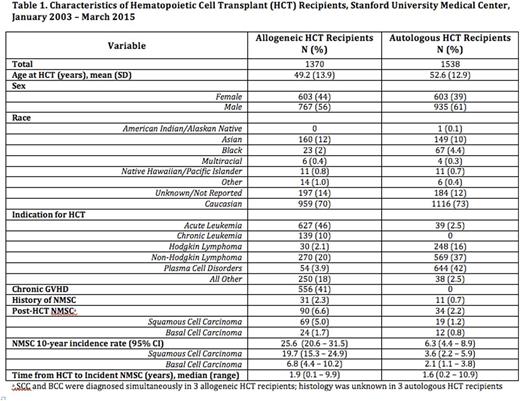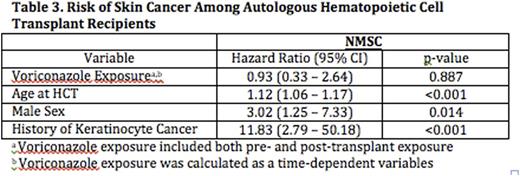Abstract
Introduction: Recipients of hematopoietic cell transplant (HCT) are at increased risk for secondary malignancy, most commonly non-melanoma skin cancer (NMSC) including cutaneous squamous cell carcinoma (SCC) and basal cell carcinoma (BCC) (Leisenring et al J Clin Oncol 2006).While both SCC and BCC are generally associated with low mortality, HCT recipients are more likely to develop clinically aggressive forms of disease associated with poorer prognosis and requiringchemoradiotherapy(Lott et al Transplantation 2010).
Voriconazolehas been available since 2002 for the treatment of serious fungal infections, and has contributed to improved clinical outcomes in patients who undergo HCT. However,voriconazoleis associated with several known cutaneous toxicities including photosensitivity, and along with its metabolite,voriconazoleN-oxide, sensitizes keratinocytes to UVA light and may cause DNA damage and inhibition of repair mechanisms (Onaet alBr J Dermatol 2015). While the association betweenvoriconazoleuse and NMSC has been established in the solid organ transplant population (Singer et al J Heart Lung Transplant 2012), less is known about HCT patients. Therefore, we sought to determine the post-HCT risk of NMSC related tovoriconazoleuse.
Methods: We performed a retrospective cohort study by exposure tovoriconazolefor allogeneic (n = 1370) and autologous (n = 1538) HCT recipients at Stanford University Medical Center between January 2003 and March 2015. Post-HCT incidence rates (IR) and hazard ratios (HR) were calculated based on first diagnosed NMSC after HCT. Multivariate analysis includedvoriconazoleexposure and known risk factors for NMSC including history of chronic graft-versus-host disease, age at transplant, sex, race, and history of NMSC.
Results: The 10-year IR for NMSC in the overall HCT population was 14.1 (95% CI = 11.7 - 16.8) and time to incident NMSC ranged from 0.1 to 10.9 years post-transplant.
Among allogeneic HCT recipients, 90 patients developed NMSC with a 10-year IR of 25.6 (95% CI = 20.6 - 31.5) (Table 1). The median time from HCT to first diagnosis of NMSC was 1.9 years (range 0.1 - 9.9 years). The 10-year IR for SCC was 19.7 (95% CI = 15.3 - 24.9) and 6.8 (95% CI = 4.4 - 10.2) for BCC (Table 1). NMSC occurred more often on the head and neck in the exposed cohort compared to the unexposed cohort (p = 0.020). In multivariate analyses, among allogeneic HCT recipients,voriconazoleuse was associated with an increased overall risk for NMSC (HR = 1.86, 95% CI = 1.18 - 2.92, p = 0.008) (Table 2). The association withvoriconazoleexposure was largely for SCC (HR = 2.12, 95% CI = 1.26 - 3.57, p = 0.005). Exposure tovoriconazoledid not appear to affect the risk for BCC (HR = 1.03, 95% CI = 0.43 - 2.46, p = 0.954).
Among autologous HCT recipients, 34 developed NMSC with a 10-year IR of 6.3 (95% CI = 4.4 - 8.9) and a median time from HCT to diagnosis of 1.6 years (range 0.2 -10.9 years) (Table 1). The 10-year IRs among autologous HCT recipients for SCC and BCC respectively were 3.6 (95% CI = 2.2 - 5.9) and 2.1 (95% CI = 1.1 - 3.8) (Table 1). In the multivariate analysis, we found no relationship betweenvoriconazoleuse and risk for NMSC (HR = 0.93, 95% CI = 0.33 - 2.64, p = 0.887) (Table 3).
Conclusion: There is a high rate of incident NMSC in the post-HCT setting with a wide range of times to diagnoses, and voriconazoleuse represents a novel factor that may contribute to increased risk for SCC in the allogeneic HCT population. Our data indicate that any history of exposure to voriconazolemay increase the risk of SCC, but not BCC, in allogeneic but not autologous HCT recipients. While other factors have greater impacts on HCT recipientsÕ risk of NMSC, the widely accepted use of voriconzaoleas either a prophylactic or therapeutic anti-fungal agent in HCT recipients makes it an important consideration in overall risk assessment.Regardless ofvoriconazole exposure, NMSC is prevalent in the post-HCT setting and there is a critical need for patient education and regular, vigilant surveillance by an experienced dermatologist to screen for and treat early skin cancer or precursor lesions.
No relevant conflicts of interest to declare.
Author notes
Asterisk with author names denotes non-ASH members.




This feature is available to Subscribers Only
Sign In or Create an Account Close Modal